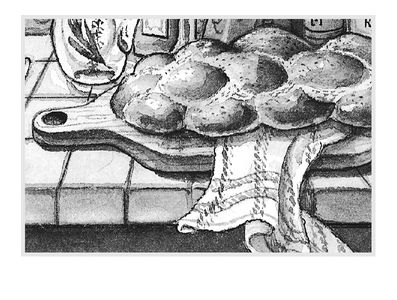China Bayles' Book of Days (68 page)
Read China Bayles' Book of Days Online
Authors: Susan Wittig Albert
Tags: #Fiction, #Mystery & Detective, #General

—BLEEDING HEARTS: A CHINA BAYLES MYSTERY
Piney, Pungent, Plentiful
Here at Meadow Knoll, the juniper branches are weighed down with ripe berries and feasting birds: the here-for-the-winter cedar waxwings, dapper birds with neat black masks and tails that look as if they’ve been dipped in yellow paint. They’re in cahoots with the blackbirds and robins, and they’re gobbling the silvery-blue berries as fast as they can. If I don’t hurry, I won’t get my share.
Maybe you’ve never used juniper berries in cooking, but if you’ve ever had a gin and tonic, you’ve tasted their clean, pine-flavored pungency. And you’ve seen the shrub everywhere, for
Juniperus communis,
originally a native of Europe, is now as common as . . . well, weeds. Ours (we have Ashe junipers) grow as tall as 20 feet. The yellow pollen puffing from the male trees in late December is an astonishing sight—and sheer misery for those with allergies.
If juniper is a new herb for you, try the dried culinary berries that come from Macedonia and Albania. (You may have to find a mail order source.) Juniper is often associated with wild game cooking, but it’s good with beef, pork, sauerkraut, and other strong-flavored vegetables. The berries are often used in marinades and sauces that feature red wine, garlic, rosemary, thyme, or bay. You’ll need only three or four, lightly crushed.
Juniper has long been used for medicinal purposes. The volatile oils aid digestion and reduce gas, although they may be dangerous for pregnant women and people with kidney ailments. Externally, juniper has been used in liniments and poultices to ease pain in the joints or muscles, or in a stimulating bath.
And if you’re troubled by witches, juniper is just what the doctor ordered. Witches were said to be offended by the pungent scent, and the plant was burned as an incense in exorcisms. Wear a sprig around your neck to ward off the attacks of wild animals and snakes. And plant a juniper beside your front door. One legend says that a witch cannot pass it until he or she has counted every twig.
Excuse me. If I don’t get outside with my basket, the birds will beat me to the last of the juniper berries.
NOVEMBER 28
Today is National French Toast Day.
Savory French Toast
French toast isn’t just for breakfast, you know. Here is a savory herbal treat that’s perfect for a Sunday brunch, especially when the tomatoes are served on an arugula bed, and the plate is accompanied by a bowl of hot soup.
SAVORY FRENCH TOAST & HAM WITH BROILED TOMATOES
4 eggs, beaten
¼ cup milk
1 cup shredded Swiss cheese
2 tablespoons finely chopped green onion tops
1 tablespoon minced parsley
1 teaspoon prepared horseradish sauce or
grated horseradish
2 teaspoons prepared mustard
4 teaspoons butter
8 slices bread
4 thin slices ham
In a shallow bowl, whisk together the eggs, milk, Swiss cheese, onions, parsley, horseradish, and mustard. Melt the butter in a large skillet over medium heat. Dip slices of bread into the egg mixture, then place them in the skillet. Cook for 3-5 minutes on each side, or until lightly browned on both sides. Remove bread from skillet. Layer 4 slices with ham; cover with remaining four bread slices. Return sandwiches to skillet; cook until bread has browned. Serve hot, with broiled ripe tomatoes. Makes 4 sandwiches.
To broil tomatoes
: Slice 4 medium-ripe tomatoes in half. In a pie plate, mix 2 tablespoons olive oil and 2 tablespoons balsamic vinegar. Marinate the tomatoes cut side down for 10 minutes. Place cut side up on foil-lined baking sheet. Sprinkle with 2 teaspoons dried basil and 4 tablespoons grated Parmesan. Broil for 5-7 minutes, until cheese is brown.
Clear moon, frost soon.
A curdly sky
Will not leave the earth long dry.
—TRADITIONAL WEATHER LORE

NOVEMBER 29
He that is merry of heart hath a continual feast.
—PROVERBS 15:15
Herbs for a Healthy Heart
Cardiac health—in a broader sense, the health of the entire circulatory system—ought to be at the top of everyone’s list of health concerns. You no doubt already understand the importance of a low-fat diet, weight control, exercise, hypertension management, and you don’t smoke. But herbs can be an important part of an overall holistic program of cardiovascular health, as well—especially if you grow them yourself and enjoy the beneficial exercise of gardening. Here are just a few of the herbs that have been recommended for circulatory health, along with a list of resources for you to explore. (As with any medication, consult your physician before using herbs therapeutically.)
• Garlic has been demonstrated to lower cholesterol, reduce blood pressure, and help prevent blood clots.
• Hawthorn helps to dilate coronary blood vessels, thereby improving the flow of blood to the heart. The leaves, flowers, and berries contain antioxidants and flavonoids that seem to strengthen the heart muscle, reduce blood levels of cholesterol and triglycerides, and lower high blood pressure.
• Ginger, traditionally used as a digestive aid, helps to control several key risk factors for circulatory disease: cholesterol, blood pressure, plaque build-up, and blood clotting.
• Ginkgo (
Ginkgo biloba
) is widely used in Oriental medicine to treat many heart and circulatory diseases. Plant chemicals improve arterial blood flow, reduce the risk of clotting, and enhance recovery from stroke.
• Turmeric (
Curcuma longa
) stimulates the production of bile, thereby lowering serum cholesterol levels. A powerful antioxidant, it may inhibit the formation of blood clots that can lead to heart attack.
Hawthorn Berry Syrup. Cover the freshly gathered fruit with water and boil until the fruit is soft. Strain off the juice and return the pulp to the kettle and make a second extraction. For every 2 cups of juice, add 1 cup sugar. Boil until thick and syrupy. Pour into sterilized bottles. Refrigerate and use within two weeks.
More Reading:
Healthy Heart: Strengthen Your Cardiovascular System Naturally,
by David Hoffman
NOVEMBER 30
Herb Garden Olive Oil
This is the time of year I always make herbed oils for gifts. I’m always careful, because several years ago, herbed oils were incriminated in at least one (and possibly more) cases of deadly botulism. If you follow some commonsense rules as you make these oils for friends or for yourself, you won’t stir up any trouble. Be scrupulously clean, sterilize the bottles, and store your oil in the fridge.
This is my favorite recipe. As with vinegar, you can experiment with flavors until you find what suits you.
HERBED OLIVE OIL
6 sprigs fresh rosemary, 3 inches long,
or 1 tablespoon dried
3 sprigs fresh thyme, 1 teaspoon dried
3 fresh sprigs oregano, or 1 teaspoon dried
2 large bay leaves
8 whole black peppercorns
3 cloves garlic, cut in eighths
1 quart extra-virgin olive oil
Wash the herbs and pat dry with a paper towel. Place in a sterilized 1-quart jar. Add olive oil, being sure to cover the herbs, pushing them down, if necessary. Cover and refrigerate for 10 days. (It coagulates when cold.) Taste. If more flavor is desired, continue to taste every 2 days. When you like the flavor, bring to room temperature and strain into a clean bottle. Refrigerate. To give, rebottle in a pretty bottle with a raffia tie. Label with this instruction:
Store in refrigerator. Bring to room temperature before use.
If you have parsnips but no sugar, don’t lose heart! Make Parsnip-Cakes!
Parsnip-Cakes. Scrape some Parsnip-Roots, and slice them thin, dry them in an Oven and beat them to Powder; mix them with an equal quantity of Flour, and make them up with Cream and Spices powder’d; then mould them into Cakes, and bake them in a gentle Oven.—N.B. The Sweetness of the Parsnip Powder answers the want of sugar.
—R. BRADLEY, THE COUNTRY HOUSEWIFE AND
LADY’S DIRECTOR, 1732
Read more about olives:
Olives : The Life and Lore of a Noble Fruit,
by Mort Rosenblum
DECEMBER 1
Come along inside . . . We’ll see if tea and buns can make the world a better place.
—KENNETH GRAHAME, WIND IN THE WILLOWS
A Cup of Comfort
Got the winter sniffles? A comforting cup of herbal tea may put you on the road to recovery a little faster. Here are some herbal remedies for what ails you.
GINGER AND LEMON TEA FOR COLDS AND FLU
1½ cups water
½ cup lemon juice
4 slices fresh gingerroot, about ¼-inch thick
¼ teaspoon cayenne
1 tablespoon honey
Bring water to a boil in a nonreactive pan. Bruise the slices of gingerroot and drop them into the boiling water. Reduce heat and simmer about five minutes. Remove from heat, strain into a cup. Add lemon juice, honey, and cayenne. Stir and sip.
THYME, SAGE, AND PEPPERMINT TEA FOR COUGHS AND FEVER
1 teaspoon dried thyme
1 teaspoon dried sage
1 teaspoon dried peppermint
1 cup boiling water
Place the herbs in a tea ball or strainer in a cup. Pour the boiling water over them, cover and steep 8-10 minutes. Sweeten with honey. Sip while warm, up to two cups a day, for 3-4 days.
LAVENDER, ROSEMARY, THYME TEA FOR HEADACHES
½ teaspoon dried lavender flowers
½ teaspoon rosemary, bruised
½ teaspoon thyme
1 cup boiling water
Place the herbs in a tea ball or strainer in a cup. Pour the boiling water over them, cover and steep for 8-10 minutes. Sweeten with honey. Sip while warm.
Learn more about making herbal tea:
A Cozy Book of Herbal Teas: Recipes, Remedies, and Folk Wisdom
, by Mindy Toomay
There are no flowers that never fade,
yet here are the chrysanthemums
blooming in winter.
—YUAN HUNG-TAO, 1568-1610

DECEMBER 2
“I’m afraid we need to talk to you about a rather difficult subject,” I said, when Hazel Pennyroyal answered Ruby’s knock. “It has to do with your brother’s will.”
Hazel opened the door wider. “The best place for difficult conversations is the kitchen. Anyway, I’m making soap and it needs stirring. Come on.”
“Making soap?” Ruby asked curiously. “Isn’t that a lot of work?”
“Not the way I do it,” Hazel said. We followed her into the kitchen, where she went to the stove and picked up a spoon to stir something in saucepan. The whole kitchen smelled of roses.
—“A PENNYROYAL PLOT” IN AN UNTHYMELY DEATH AND
OTHER GARDEN MYSTERIES
Herbal Soaps
You can lather up with soapwort or yucca—or you can make your own sweet-smelling herbal soaps, another easy project for children, and perfect for holiday gift-giving.
HAZEL PENNYROYAL’S EASY HERBAL SOAP
